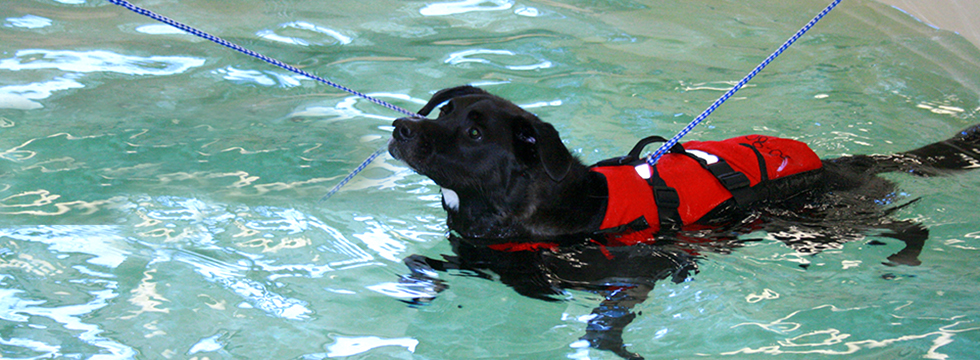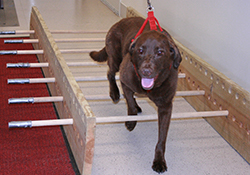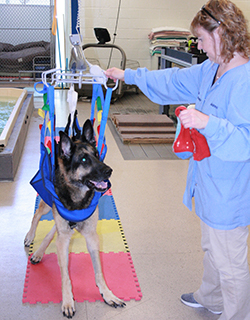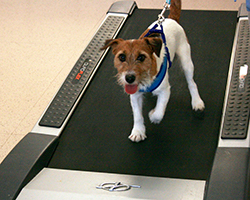
Post-Surgery Rehabilitation Has Gone to the Dogs
A chocolate lab wearing a flotation harness swam laps in a small pool, pausing every few seconds to lap up the water, while a Jack Russell terrier enjoyed the view from atop a balance ball, playfully shifting his weight from paw to paw. Across the room, a beagle mix scampered through a short obstacle course.
Dogs of varying shapes and sizes received rehabilitative therapy on a recent morning at the Lloyd Veterinary Medical Center at Iowa State University, but the scene resembled recess as much as medical rehabilitation.
But Cash, a full-grown German shepherd, could only watch from his cushion on the floor. Cash recently underwent neck surgery for spinal compression, and he couldn’t walk on his own. So he gnawed away at his chew toy and occasionally sniffed in the direction of the other dogs when one wandered close enough. But, for the most part, he had to stay put.
That is, until Joanna Hildreth, a certified canine rehabilitation practitioner, loaded him up in a harness attached to a track on the ceiling. With some gentle guidance from Hildreth (and the promise of regaining his prized chew toy), Cash swiped his big paws at the floor in a rough walking motion. For a few minutes, Cash was up and moving again.
The canine rehabilitation center at Iowa State offers injured and recovering animals a chance to regain strength, balance and range of motion through the use of cutting-edge equipment and veterinary expertise. ISU veterinary students also benefit from the facility through two-week rotations and volunteer experience. And, if the wall full of heartfelt thank-you notes from pet owners is any indication, the rehabilitation center significantly improves the quality of life for the animals that undergo treatment.
Rehabilitation can minimize recovery time and maximize results following surgery, said Mary Sarah Bergh, an associate professor of veterinary clinical sciences who works in the rehab center. In human medicine, patients often begin rehab almost immediately after some surgeries. The same applies to animals, Bergh said.
“Just think if you or I were to have orthopedic or neural surgery, we’d be starting physical rehabilitation the night of surgery or the next day,” Bergh said. “There are proven benefits there for humans. The same thing holds true for animals.”
Paws on Treadmills
Most of the dogs who receive treatment in the rehab center have recently undergone neurologic or orthopedic surgery, Bergh said. The facility features a wide range of therapies to help dogs recover. Aquatic therapy, in the form of a swimming pool and an underwater treadmill, minimizes the force applied to muscles and joints while allowing the animal to build strength and improve range of motion.
After Cash the German shepherd had taken several laps across the room in his harness, he spent a few minutes in the underwater treadmill, which allows animals to regain mobility without putting full weight on their legs, Bergh said. To the untrained eye, his movement in the water looked like that of a healthy dog.
Dogs also can spend time on a balance ball to help with weight shifting and bearing as well as building strength in the core muscles, or they can run through Cavaletti rails to improve balance and coordination.
Handwritten cards and thank-you notes cover a bulletin board in the corner of the room, a testament to the results the rehabilitation efforts have achieved. “She gets stronger every day,” reads a note from one pet owner. “We couldn’t have recovered from our surgery as well without you,” reads another.
Some of them are written from the perspective of the patients, though it’s not clear how a dog might hold a pen. “I am taking walks and love to be outside…” says one note from a dog documenting its improvement after receiving rehabilitative treatment.
Bergh said watching that improvement is profoundly rewarding, both for her and the veterinary students who work in the facility.
“You can see the energy and the life return to an animal,” she said.
Fourth-year veterinary students can complete a clinical rotation in the canine rehab center, gaining hands-on experience with the animals and the equipment. Students also volunteer in the rehab center earlier in their vet-school tenure, she said.
As for Cash, his recovery will be a long and challenging one, Bergh said. But, with the combination of innovative techniques and expertise available at the canine rehabilitation center, it’ll be possible – though he’ll have to take it one step at a time.
July 2017



